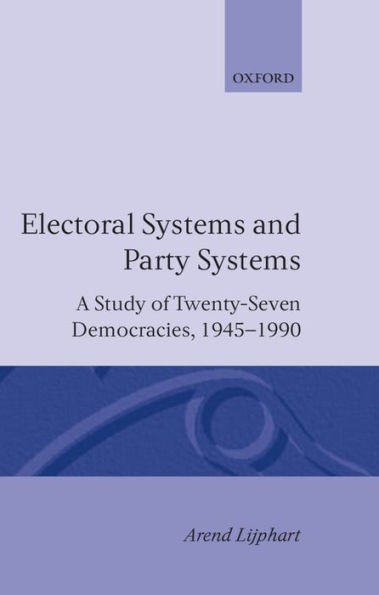Electoral Systems and Party Systems: A Study of Twenty-Seven Democracies, 1945-1990
The most fundamental element of representative democracy is the electoral system—translating citizens' votes into representatives' seats. Electoral systems are also the most practical and accessible instrument available to democratic reformers. This systematic and comprehensive study describes and classifies 70 electoral systems used by 27 democracies including those of Western Europe, the United States, Australia, Canada, Costa Rica, India, Israel, Japan, and New Zealand. Using comparative and statistical analysis of these systems, Arend Lijphart demonstrates the effect of the electoral formula used, the number of representatives elected per district, electoral thresholds, and five other key features of electoral systems on the proportionality of the election outcome, the degree of multipartisanism, and the creation of majority parties. In the process, he reveals that electoral systems are neither as diverse nor as complex as is usually assumed. The most definitive treatment of the subject since Rae's classic study in 1967, this book is based on more accurate and comprehensive data covering more countries and a longer time-span and uses stronger hypotheses and better analytical methods. The unique information and analysis it offers will make it essential reading for scholars and students of comparative politics.
1101402782
Electoral Systems and Party Systems: A Study of Twenty-Seven Democracies, 1945-1990
The most fundamental element of representative democracy is the electoral system—translating citizens' votes into representatives' seats. Electoral systems are also the most practical and accessible instrument available to democratic reformers. This systematic and comprehensive study describes and classifies 70 electoral systems used by 27 democracies including those of Western Europe, the United States, Australia, Canada, Costa Rica, India, Israel, Japan, and New Zealand. Using comparative and statistical analysis of these systems, Arend Lijphart demonstrates the effect of the electoral formula used, the number of representatives elected per district, electoral thresholds, and five other key features of electoral systems on the proportionality of the election outcome, the degree of multipartisanism, and the creation of majority parties. In the process, he reveals that electoral systems are neither as diverse nor as complex as is usually assumed. The most definitive treatment of the subject since Rae's classic study in 1967, this book is based on more accurate and comprehensive data covering more countries and a longer time-span and uses stronger hypotheses and better analytical methods. The unique information and analysis it offers will make it essential reading for scholars and students of comparative politics.
170.0
Out Of Stock
5
1

Electoral Systems and Party Systems: A Study of Twenty-Seven Democracies, 1945-1990
228
Electoral Systems and Party Systems: A Study of Twenty-Seven Democracies, 1945-1990
228Related collections and offers
170.0
Out Of Stock

Product Details
| ISBN-13: | 9780198273479 |
|---|---|
| Publisher: | Oxford University Press |
| Publication date: | 03/10/1994 |
| Series: | Comparative Politics |
| Pages: | 228 |
| Product dimensions: | 8.50(w) x 5.50(h) x 0.69(d) |
About the Author
From the B&N Reads Blog
